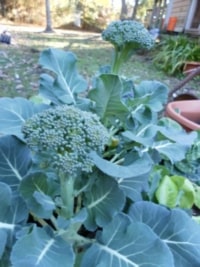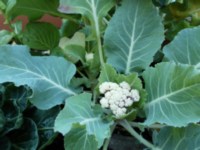
Winter Garden Tips
Protect tender perennials from cold with several inches of mulch.
Cut back freeze damaged plants below damaged area after the last frosts of the season.
Protect potted tropical & tender plants from freezes by bringing them indoors in a garage or greenhouse. In ground plants can be transplanted to pots or tented by using plastic and wooden stakes. Do not let plastic come into contact with the plant leaves to avoid frost. Open the tent to air the next morning after the freeze has past as the sun can heat up the tent & burn plants when the sun comes up. Don’t forget to return plants outdoors after the threat of frost has past.
Begin to plant tulip and hyacinth bulbs that have been refrigerated for at least 6 weeks until early January.
Roses can be transplanted through late February.
Also cut back fall-blooming perennials after they have bloomed.
Cool Season Vegetables to Plant in January

Vegetables to plant in January include beets, broccoli, cabbage, carrots, cauliflower, celery, Chinese cabbage, collards, garden peas, kale, kohlrabi, leeks, lettuce, mustard, radishes, rutabaga, snow peas, spinach, Swiss chard, and turnips. Winter is an excellent time to collect soil samples and submit them for analysis before preparing for spring planting. Samples should be a composite of soil taken from about 3 to 4 inches deep at various places around the lawn.
Cabbage, Broccoli, Cauliflower and Chinese Cabbage: Cabbage planted now may encounter low temperatures. Temperatures in the low 20s will injure some of the cabbage, and lower temperatures will freeze many varieties.
Recommended varieties for winter production are Bravo, Cheers, Blue Vantage,Emblem, Vantage Point and Rio Verde. For reds, try Cardinal, Red Rookie 831 or Red Rookie.
Bolting may occur. Bolting is caused when plants go dormant because of prolonged exposure to cooler temperatures (45 F and lower). Bolting of the cool-season crops also will occur when late-season crops are exposed to hot temperatures. Each of these vegetables can be planted directly into the field during January. Cauliflower and Chinese cabbage should not be transplanted until February.
Irish potatoes: Begin planting Irish potatoes around mid-January. Fertilize at the rate of 7 to 8 pounds of a complete fertilizer (8-8-8, 13-13-13) or 8-24-24 per 100 feet of row before planting (0.7-0.8 pounds per 10 feet of row).
Cut seed potatoes into blocky pieces that weigh about 1½ to 2 ounces each or are about the size of an egg. Be sure each seed piece has at least one eye; this is where the plant will originate. Irish potato plants may be nipped back by a light frost, but damage usually is not serious. Plant seed pieces 10 to 15 inches apart in the row.
Winter Soils
Now is a good time to have your sample tested. Bring about 1 pint of soil to your parish’s LSU AgCenter Extension Service office or a participating garden center. Make sure to specify the type of grass you are growing on the soil test form. Soil samples submitted to the LSU AgCenter cost only $10, and they provide a wealth of information concerning the overall fertility of your soil.
If results of the soil test indicate the soil pH is too acidic, lime will be prescribed in the soil test recommendations. Winter is the best time to apply lime so it can be fully activated by the following spring. The correct soil pH is extremely important and has everything to do with nutrient availability to your lawn’s roots and to fertilizer performance.
Preparing Roses for Spring Blooms

Roses should be pruned anytime from late January (south Louisiana) through mid-February (north Louisiana).
This pruning is especially important for hybrid tea and grandiflora roses. Without this annual pruning, these roses generally become leggy, less vigorous and unattractive and do not bloom as well. In general, however, all types of roses usually require some pruning each year to control their shape or size.
Use sharp bypass hand pruners on roses. Should you need to cut canes larger than one-half inch in diameter, you should use bypass loppers. Hybrid tea and grandiflora roses generally are cut back to about 18 to 24 inches from the ground. Other types of roses that are everblooming (such as China, tea, noisette, Bourbon, polyantha, floribunda, landscape and miniature roses) also may be pruned now. In general, roses in these categories have more pleasing shapes without severe pruning. Unless there is a need to control their size, they are only lightly shaped under most circumstances.
First, prune out any dead or diseased canes. To shape the bushes, you can use hand pruners to selectively cut back individual branches. Landscape roses can even be sheared with hedge shears to shape them and encourage full, bushy growth. If some of your bushes are considerably overgrown, they will tolerate severe pruning to get them back into shape. Other than hybrid teas and grandifloras, roses are cut back about one-third to one-half their height, depending on the situation. Long, especially vigorous shoots that have grown well beyond the rest of the bush and make it look out of balance may be cut back further than the rest of the bush. Young bushes planted within the last year or two likely will not need drastic pruning but may be cut back slightly to encourage a full, bushy plant. It is easier and healthier for the rose bush if you prune at least once a year. It is very difficult to properly prune a rose bush that has been allowed to grow for several years without pruning. Don’t forget that we also do a second, but not as severe, pruning on ever blooming roses in late summer through late August.
submitted by Karen Blackburn
